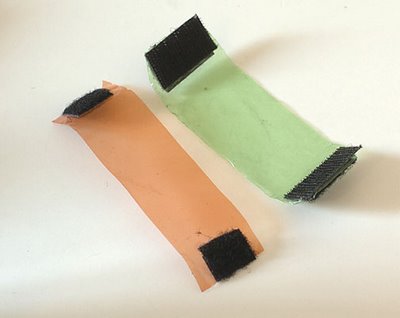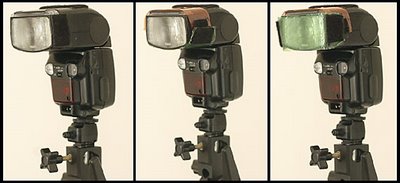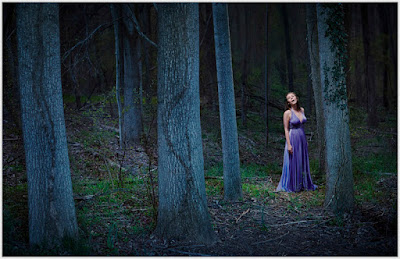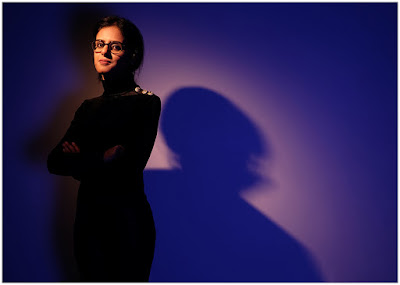Lighting 101: Using Gels to Correct Light
Abstract: A first taste at using gels to color your light. We'll be getting way more into this in Lighting 103. [This post was updated on Feb. 5, 2020.]

(Photo by Strobist reader Siddarth Siva)
Some you may be starting to realize already, but I'll say it aloud:
When lighting a photo it is not about absolute light levels. It's about relative levels. You can adjust for just about any overall light level you have by simply changing the overall exposure on your camera. So that zeroes the "absolutes" out.
It is the relative light levels that define the look of your photos. And for shorthand, we call this a "lighting ratio." I.e., what is the ratio of brightness between the highlights and the shadows?
Guess what? Lighting color sort of works the same way. Only instead of adjusting the exposure, we can instead adjust the camera's white balance to zero out the color of a light source.
For instance, if you were in a fluorescent room, you might balance on the "FL" white balance to make ambient light photos. Since FL lights are in fact green (mostly, but pretty variable these days) your camera would compensate by shifting the color balance about 30CC units of magenta. (That's the complimentary color of green.
So if you used flash in that environment, and was "mixing" the balance with the ambient, your flash would appear … too magenta. Your camera is balanced for FL, and there is a daylight-colored light source. Your flash. So that light would react to the color shift in a not great way.
How do you fix this? You turn the flash's light green, like a fluorescent. And you do it with the special green "gel" (AKA "window green" pictured below:

What about those orange-tinted tungsten (AKA "incadescent") lights? What gel would they get?
Hint: It's the other gel in the photo above…
You get the picture—orange tungsten ambient light, you compensate in the camera by going to tungsten WB. And the camera adds blue to the image. So you need to make your flash orange to match.
And you do that with a tungsten gel, also known as a CTO gel. (Color temperature orange.) They can also go the other direction (physically converting a tungsten source into daylight) by using a CTB (color temperature blue) gel.
Simple to mount, you just tape or velcro them to the flash. Leave a little space to vent the heat from the tube:

Suffice to say there are many types and colors of gels. Some are used for color correction, or to evoke a place and time:

Or use can use gels and a white wall to create a look that is more theatrical:

We'll get to more of this later. Trust me, it's pretty cool.
__________
Oh, Look at That
If you look closely you'll see that the photo atop this page is an example of both color and flash/ambient balancing. And it was done so skillfully, it would be easy to miss.
It was shot by my friend Sid Siva in Dubai. He balanced his exposure by shooting wide open at a high ISO (to get a good shutter speed) and exposing for the street lights. Which looked extra cool when out of focus.
Then he added a little light into the directors face with a small off-camera flash to bring his face back out of the shadows.
But those lights in the back included tungstens, so he did the white balance swap-and-gel, too. Camera on tungsten white balance, CTO gel on the flash. Bingo. Is it starting to make sense yet?
Oh, and to get the cool, limited spot of light on filmmaker Mahmooud Kaabour's face, he used a small snoot to restrict the light.
What's a snoot?
Oh, that's just one of several different types of lighting restrictors, which we'll be talking about next...
Next: Cereal Box Snoots and GoBos

(Photo by Strobist reader Siddarth Siva)
Some you may be starting to realize already, but I'll say it aloud:
When lighting a photo it is not about absolute light levels. It's about relative levels. You can adjust for just about any overall light level you have by simply changing the overall exposure on your camera. So that zeroes the "absolutes" out.
It is the relative light levels that define the look of your photos. And for shorthand, we call this a "lighting ratio." I.e., what is the ratio of brightness between the highlights and the shadows?
Guess what? Lighting color sort of works the same way. Only instead of adjusting the exposure, we can instead adjust the camera's white balance to zero out the color of a light source.
For instance, if you were in a fluorescent room, you might balance on the "FL" white balance to make ambient light photos. Since FL lights are in fact green (mostly, but pretty variable these days) your camera would compensate by shifting the color balance about 30CC units of magenta. (That's the complimentary color of green.
So if you used flash in that environment, and was "mixing" the balance with the ambient, your flash would appear … too magenta. Your camera is balanced for FL, and there is a daylight-colored light source. Your flash. So that light would react to the color shift in a not great way.
How do you fix this? You turn the flash's light green, like a fluorescent. And you do it with the special green "gel" (AKA "window green" pictured below:

What about those orange-tinted tungsten (AKA "incadescent") lights? What gel would they get?
Hint: It's the other gel in the photo above…
You get the picture—orange tungsten ambient light, you compensate in the camera by going to tungsten WB. And the camera adds blue to the image. So you need to make your flash orange to match.
And you do that with a tungsten gel, also known as a CTO gel. (Color temperature orange.) They can also go the other direction (physically converting a tungsten source into daylight) by using a CTB (color temperature blue) gel.
Simple to mount, you just tape or velcro them to the flash. Leave a little space to vent the heat from the tube:

Suffice to say there are many types and colors of gels. Some are used for color correction, or to evoke a place and time:

Or use can use gels and a white wall to create a look that is more theatrical:

We'll get to more of this later. Trust me, it's pretty cool.
__________
Oh, Look at That
If you look closely you'll see that the photo atop this page is an example of both color and flash/ambient balancing. And it was done so skillfully, it would be easy to miss.
It was shot by my friend Sid Siva in Dubai. He balanced his exposure by shooting wide open at a high ISO (to get a good shutter speed) and exposing for the street lights. Which looked extra cool when out of focus.
Then he added a little light into the directors face with a small off-camera flash to bring his face back out of the shadows.
But those lights in the back included tungstens, so he did the white balance swap-and-gel, too. Camera on tungsten white balance, CTO gel on the flash. Bingo. Is it starting to make sense yet?
Oh, and to get the cool, limited spot of light on filmmaker Mahmooud Kaabour's face, he used a small snoot to restrict the light.
What's a snoot?
Oh, that's just one of several different types of lighting restrictors, which we'll be talking about next...
Next: Cereal Box Snoots and GoBos
__________
New to Strobist? Start here | Or jump right to Lighting 101
My new book: The Traveling Photograher's Manifesto
Permalink
<< Home